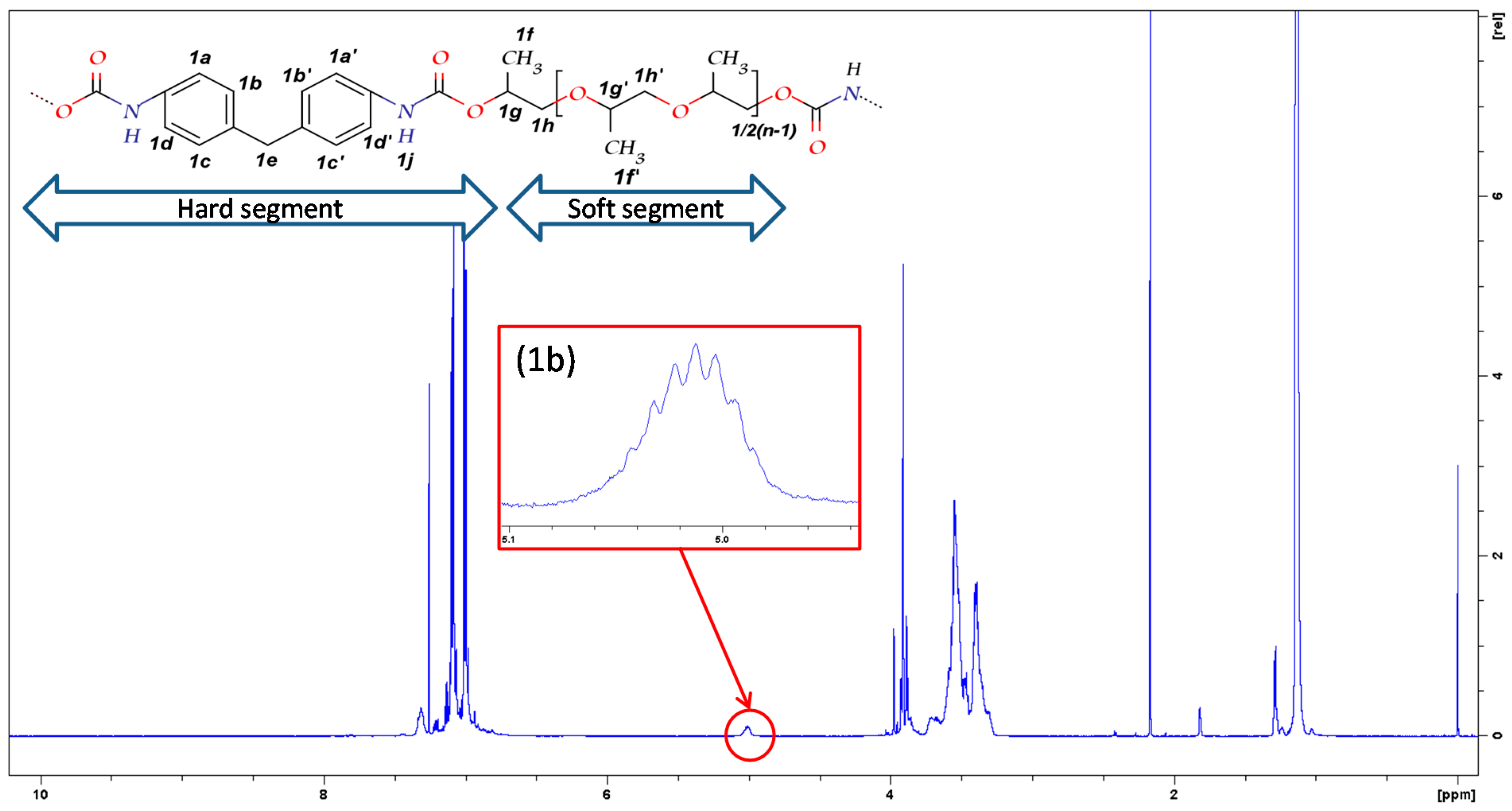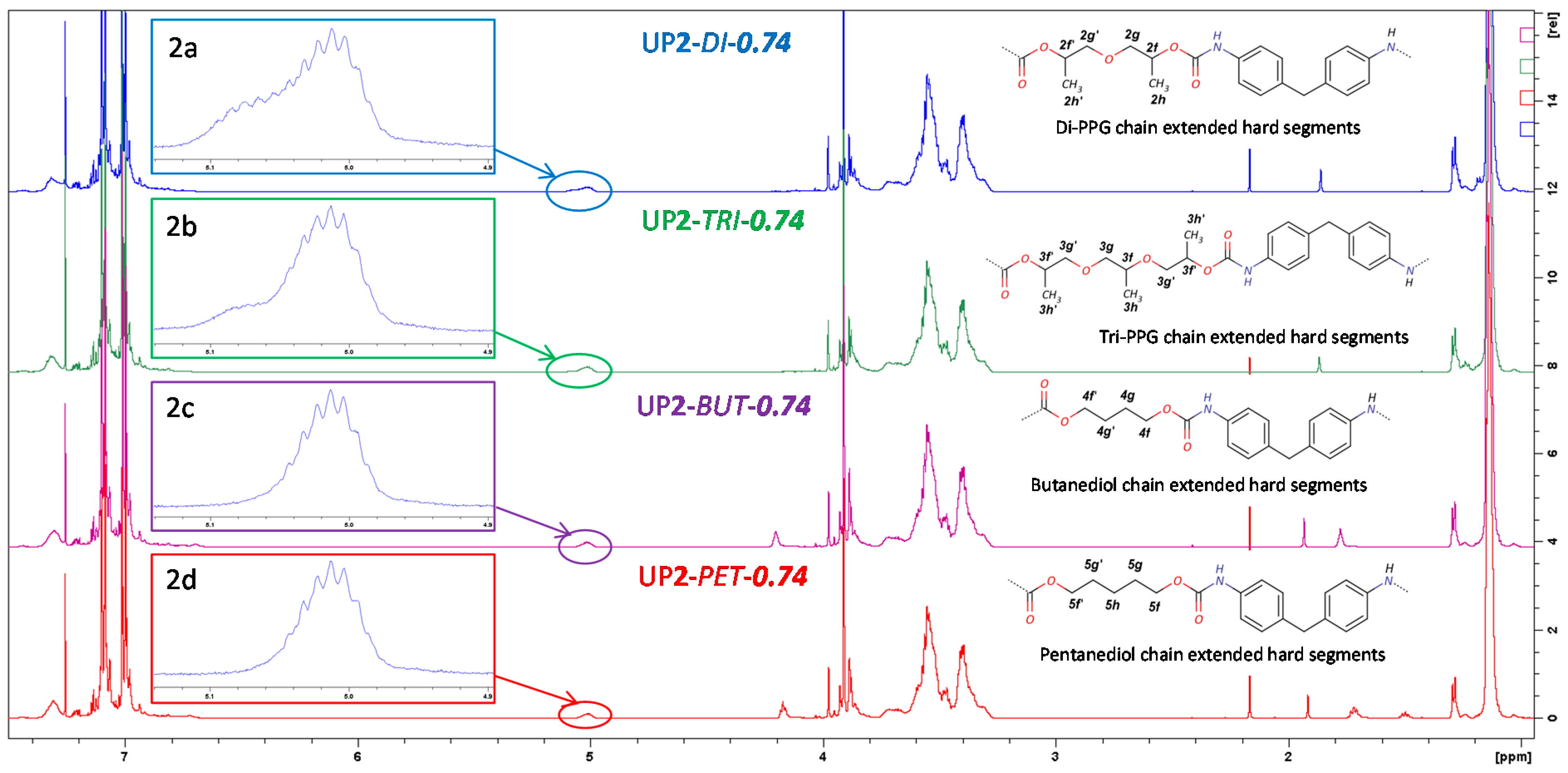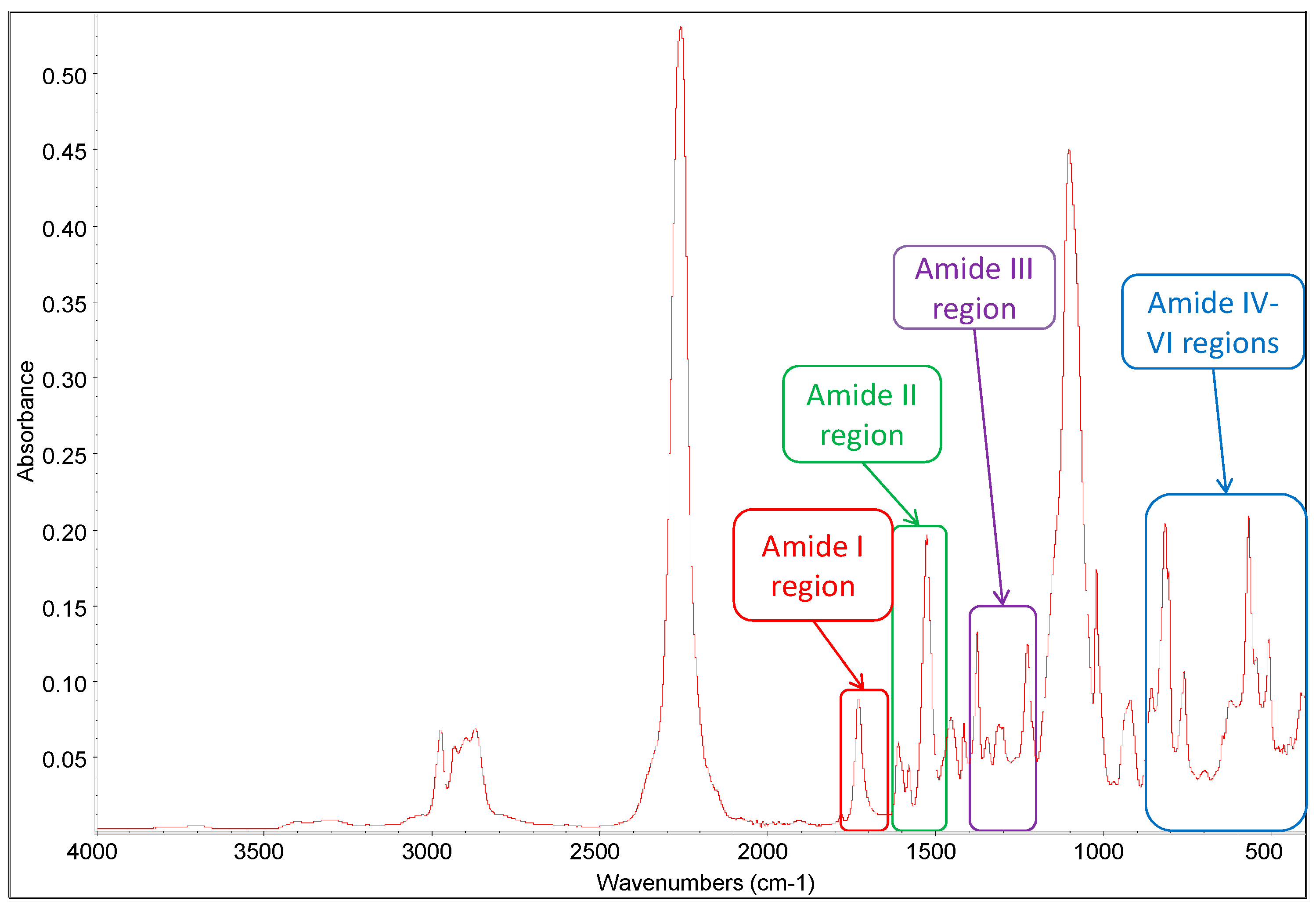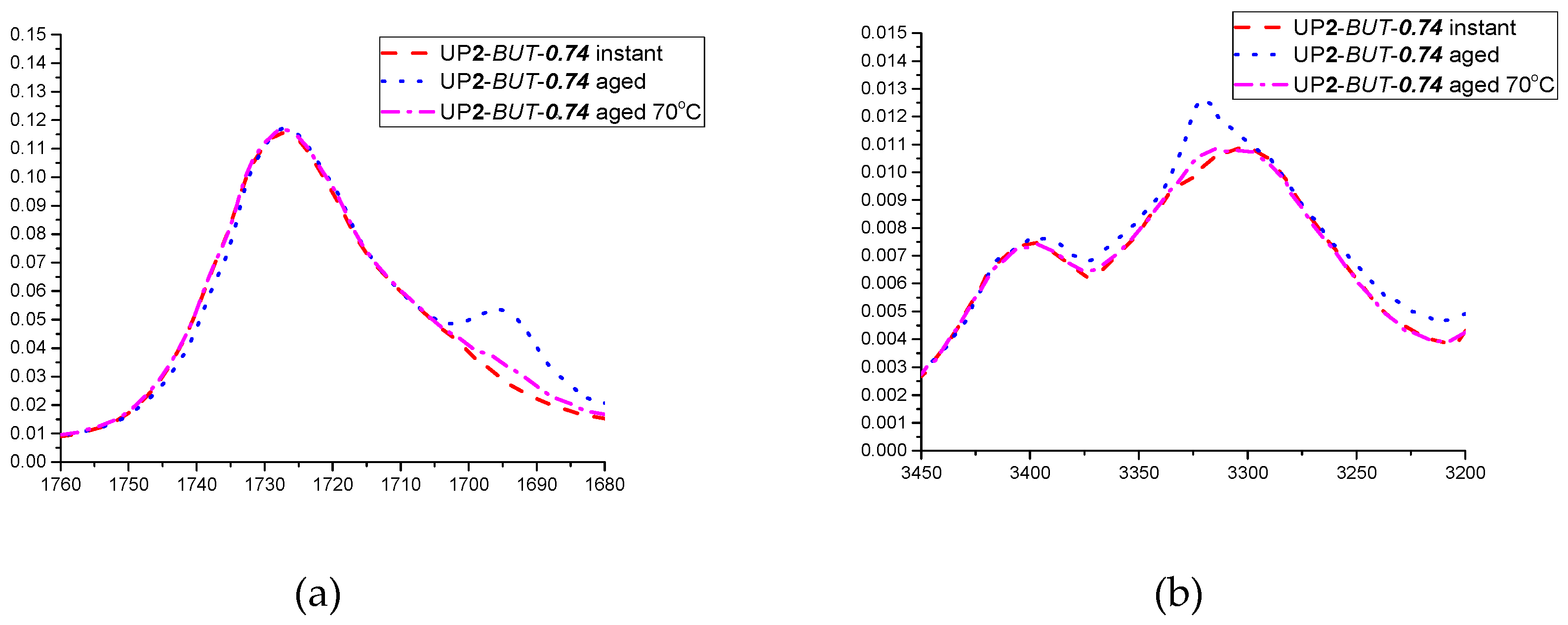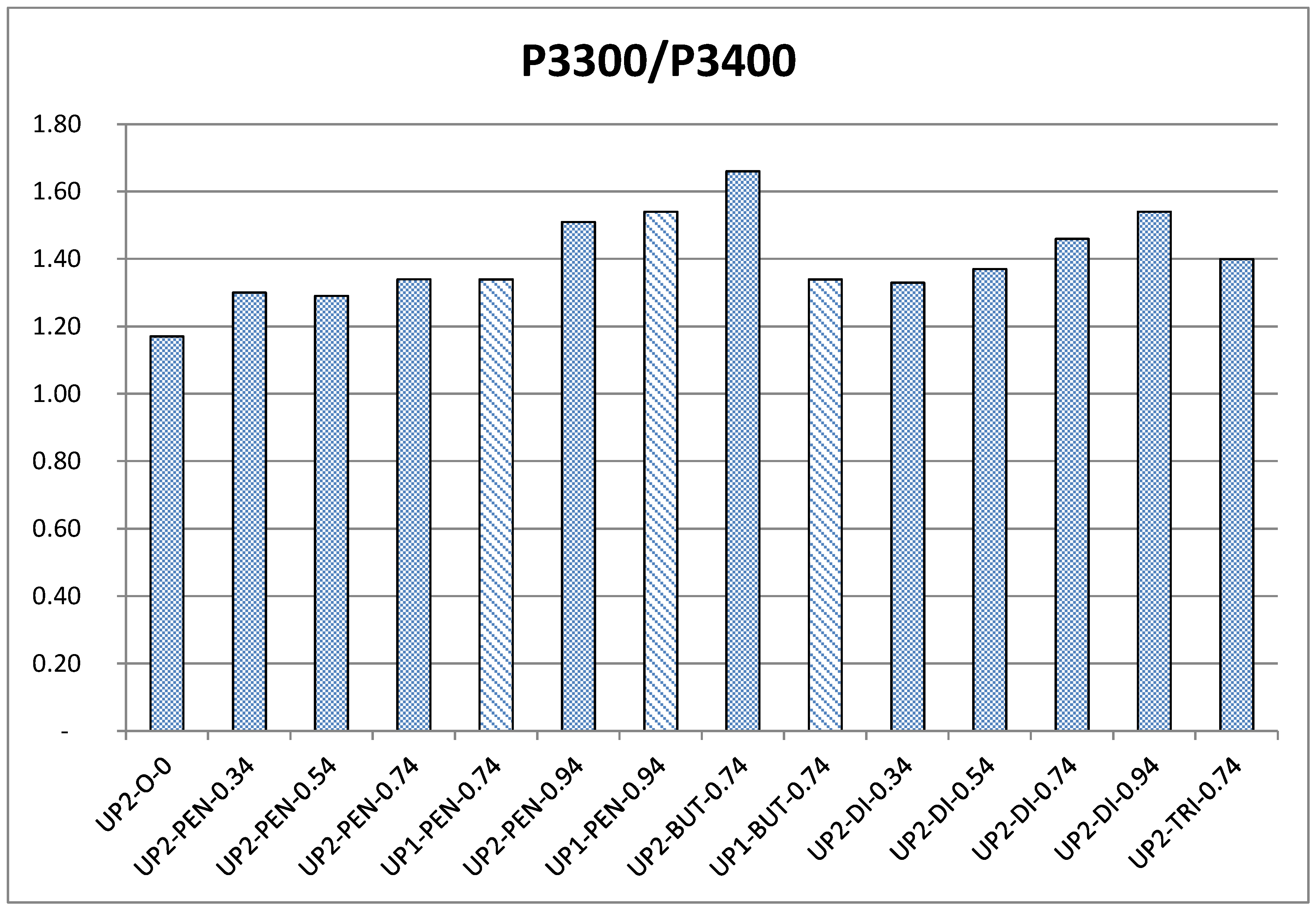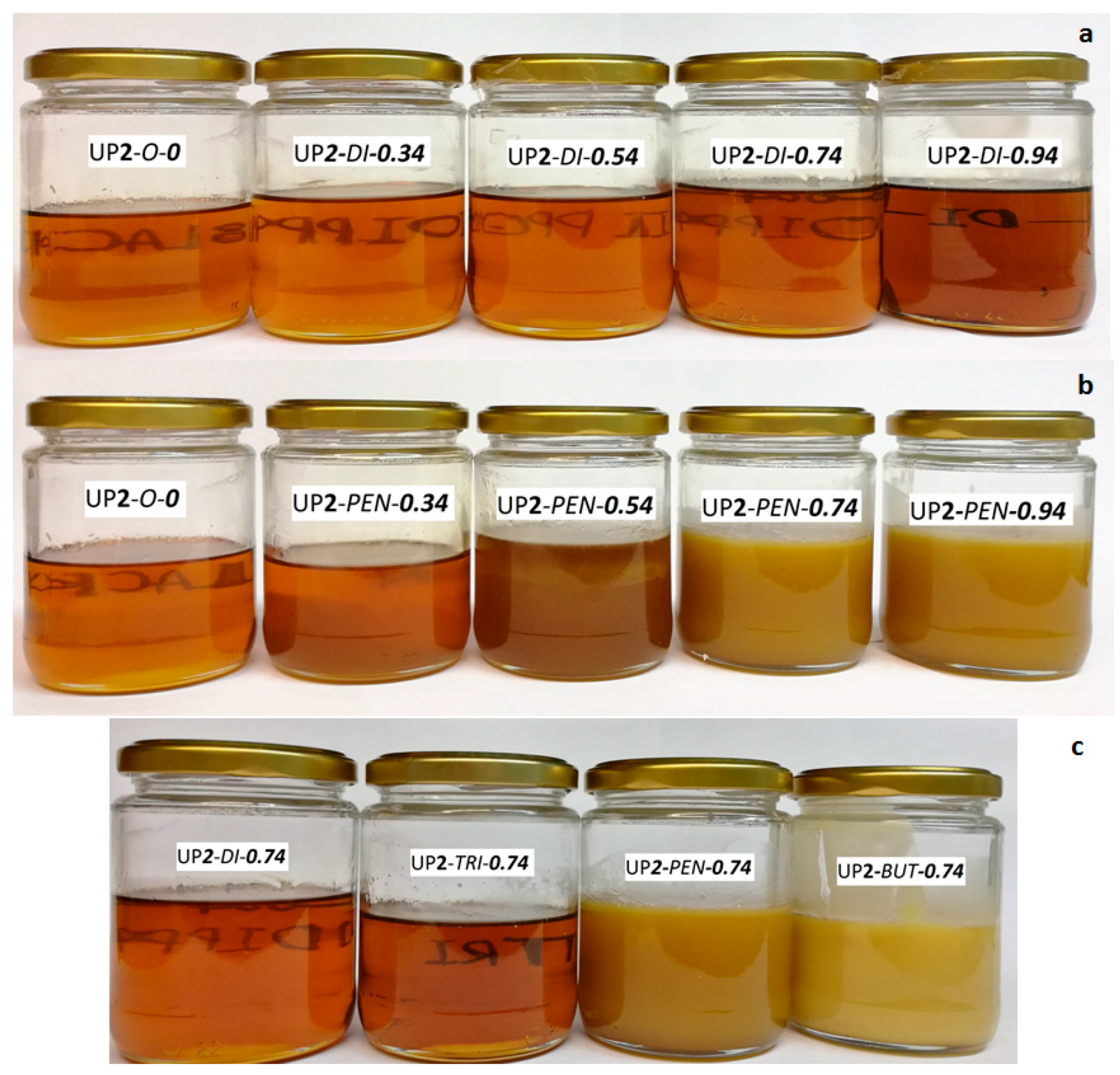3.1.2. Attenuated Total Reflectance Infrared Spectroscopy
During the synthesis of urethane prepolymers, intermediate and final polymers were analyzed by ATR-FTIR in order to monitor reaction conversions. This was accomplished by observing the changes of characteristic absorbance bands of different functional groups, such as free isocyanate and urethane groups. As the reaction between isocyanate and hydroxyl groups progressed, the intensity of the N=C=O stretching band at 2270 cm−1 decreased, and simultaneously, the intensity of the urethane C=O stretching peak at 1680–1760 cm−1 increased. The reaction was judged to be completed when no changes in the intensities of N=C=O and urethane C=O stretching peaks were recorded. The carbonyl stretching bands for urea analogues at 1625–1680 cm−1 were not found in final products, thus indicating that no significant side reactions between isocyanates with moisture had occurred during the preparation of urethane prepolymers.
The ATR-FTIR spectrum of the blank sample UP
2-
O-
0 is shown in
Figure 5, and the assignments of its characteristic peaks are given in
Table 4. In general, it has been earlier established that there are several characteristic amide absorptions in the FTIR spectrum of a polyurethane, including Amide I mode (1600–1800 cm
−1: urethane C=O stretching, C–N stretching, and C–C–N deformation), Amide II mode (1500–1600 cm
−1: N–H in-plane bending and the C–N stretching), Amide III mode (1200–1400 cm
−1: C–N stretching vibration and NH deformations) and Amide IV-VI modes (400–800 cm
−1: NH out-of-plane deformations) [
14]. The urethane C=O stretching in the Amide I region and the bands in the Amide II region are sensitive to chain conformation and hydrogen bonding interactions, and the former is valuable for this type of polyurethane studies.
Since the driving force for the formation of dual phase structure in polyurethanes is related to hydrogen bonding interactions within or between the HS and SS, the organization of polymer chains and the extent of phase separation can be investigated through analyzing the patterns of hydrogen bonding interactions, which can be achieved by studying the urethane N
–H stretching region (3200–3400 cm
−1) and the C=O stretching region (Amide I: 1680–1760 cm
−1) in FTIR spectra [
11,
14]. The hydrogen bonding associating with the urethane carbonyl group can be correlated with a shift in its stretching signals as follows: the non-hydrogen bonded carbonyl in the free urethane group is assigned to 1730–1760 cm
−1; the hydrogen-bonded carbonyl group in the disordered (amorphous) conformation is assigned to 1700–1730 cm
−1, which represents the hydrogen bonding between SS and HS; whereas the hydrogen bonded carbonyl group in ordered (crystalline) conformation is assigned to 1680–1700 cm
−1, representing hydrogen bonding within HS [
9,
23,
26]. Likewise, the free N–H (non-hydrogen bonded) and hydrogen bonded N–H absorbance bands can be assigned to 3400 cm
−1 and −3300 cm
−1, respectively [
15,
26].
In addition, in order to study the effect of aging on the formation of hydrogen bonding, ATR spectra was also recorded at different time periods within one month. It was found that most samples did not show significant changes in the ATR-FTIR spectra upon aging, except for UP
1/
2-
PEN-
0.74, UP
1/
2-
PEN-
0.94 and UP
1/
2-
BUT-
0.74. All of the samples showed a shift of carbonyl peaks to lower wavenumbers, with an increasing intensity of peaks at 1680–1700 cm
−1 and 3300 cm
−1 within 1–2 days after production, which is closely related to their tendency for forming hydrogen bonding within HS. In particular, UP
1/2-
BUT-
0.74 presented a strong shoulder peak at 1680–1700 cm
−1 and a sharp peak at 3300 cm
−1 after one day of aging, which indicated a higher content of highly ordered structures via substantial hydrogen bonding interactions within hard segments. These changes were not only time dependent, but also thermally reversible. A test was made with a one month-old UP
2-
BUT-
0.74:UP
2-
BUT-
0.74 that was reheated to 70 °C, with ATR-FTIR spectrum immediately recorded (labeled as UP
2-
BUT-
0.74 aged 70 °C). The ATR spectra of UP
2-
BUT-
0.74 at different stages (instant, aged and aged 70 °C) are compared in
Figure 6, at the C=O stretching band ranging 1680–1760 cm
−1 (left) and the N–H stretching band ranging 3200–3450 cm
−1 (right). It was clearly observed that after the thermal treatment, the ATR-FTIR spectrum of UP
2-
BUT-
0.74 aged 70 °C showed a significantly decreased intensity of peaks at 1680–1700 cm
−1 and 3300 cm
−1, which was almost identical to the initial UP
2-
BUT-
0.74 spectrum. This is because increasing temperature weakened the hydrogen bonding within HS domains, and instead improved the phase mixing of HS and SS [
15,
26].
Further ATR-FTIR spectra (C=O stretching band ranging 1680–1760 cm
−1 and N–H stretching band ranging 3200–3450 cm
−1) of one month aged samples are compared in
Figure 7.
In order to quantify the contributions of chain extenders, the intensity ratios of the peak at 3300 cm
−1 (P3300) and the peak at 3400 cm
−1 (P3400) were calculated and shown in
Figure 8.
According to
Figure 7(a1,a2) and
Figure 8, the intensity of peaks ranging between 1690 and 1720 cm
−1 and the ratio of P3300/P3400 gradually increased as the amount of di-PPG increased. Particularly, the major change in the C=O stretching band was observed at 1700–1720 cm
−1, which revealed that the majority of HSs formed disordered (amorphous) hydrogen bonding with the SSs. This is because the di-PPG contains branches that are capable of hindering the formation of highly ordered hydrogen bonding within HS. Furthermore, the structural similarity between di-PPG in HS and PPG 2000 in SS sufficiently enhanced miscibility between HS and SS [
9]. Both could explain why the incorporation of di-PPG readily promoted the formation of disordered hydrogen bonding, and thus greatly contributed to phase mixing between HSs and SSs.
As can be seen from
Figure 8, pentanediol had a more pronounced effect on the overall extent of hydrogen bond formation at higher dosages of 0.74 and 0.94 molar ratios. Moreover, it was generally observed in
Figure 7(b1) that pentanediol chain extended samples showed different changes in C=O stretching bands in comparison to di-PPG, which indicated different patterns of hydrogen bonding. At a low dosage of pentanediol (0.34 to 0.54 molar ratio), the overall extent and type of hydrogen bonding were almost the same as in the case of di-PPG (
Figure 8), where hydrogen bonding was primarily formed between HSs and SSs [
Figure 7(b1)]. Whereas, at a high dosage of pentanediol (0.74 to 0.94), a shoulder peak corresponding to hydrogen bonded C=O absorbance in ordered conformation gradually appeared at 1680–1700 cm
−1 and increased as a function of pentanediol amount, which reveals that the HSs associated into hard domains via hydrogen bonding.
The influence of chain extender structures on the formation of hydrogen bonding was investigated by comparing samples containing different chain extenders in a molar ratio of 0.74, as shown in
Figure 7(c1,c2) and
Figure 8. In general, the overall extent of hydrogen bond was similar for all of these samples, except UP
2-
BUT-
0.74 which presented a sharp peak shift to a higher wavenumber (~3320 cm
−1), and an extremely high ratio of P3300/P3400. According to
Figure 7(c1), UP
2-
DI-
0.74 and UP
2-
TRI-
0.74 had a tendency to form disordered hydrogen bonding interactions (1700–1720 cm
−1), whereas UP
2-
PEN-
0.74 and UP
2-
BUT-
0.74 exhibited more pronounced, highly ordered hydrogen bonding interactions, as evidenced by the appearance of shoulder peaks at 1680–1700 cm
−1). This peak was most intensive for UP
2-
BUT-
0.74. Combined with the findings in the N–H stretching absorbance region (
Figure 7(c2) and
Figure 8), UP
2-
BUT-
0.74 contained substantial amounts of highly ordered hydrogen-bonded structures. It has been earlier reported that linear chain extenders with an even number of CH
2 (e.g., butanediol) readily promote HS association into hard domains via hydrogen bonding, and hence enhance phase separation in comparison to the one with an odd number of CH
2 (e.g., pentanediol) [
17,
26].
The synthesis process has more influence on those samples that also otherwise tend to phase separate easily (UP
1/2-
PEN-
0.74, UP
1/2-
PEN-
0.94 and UP
1/2-
BUT-
0.74). Thus, the ATR spectra of these samples were compared in
Figure 7(d1,d2) and
Figure 8. Based on
Figure 8, the butanediol chain extended samples UP
1/2-
BUT-
0.74 were the most susceptible to the influence of the synthesis process, the one-shot sample being much less hydrogen bonded than the two-stage sample.
Figure 7(d1) gives additional support that both UP
1-
BUT-
0.74 and UP
1-
PEN-
0.94 (one-shot) showed less pronounced shoulder peak compared to their counterparts (two-stage). This finding confirms the statement that the one-shot process produce a urethane prepolymer with more randomly distributed polymer chains, and more dispersed HSs that eventually enhance phase mixing between the HS and SS [
13,
26].
3.1.3. Appearance
The appearance of the urethane prepolymers in terms of color, transparency and viscosity can be correlated with the architecture and morphology of the polymers. For instance, phase separation between SSs and HSs can cause light scattering and thereby have an influence on the transparency [
13]. The viscosity results are shown in
Table 5.
The blank samples PU
1/2-
O-
0 containing no chain extenders were clear, brownish liquids and were the least viscous (
Table 5), and their appearance did not change during storage. The brownish color was attributed to the effect of pMDI. When chain extenders were added, the viscosity of urethane prepolymers dramatically increased as the amount of chain extender increased, because the increasing amount of hard segments intermolecularly associate via hydrogen bonding, and form physical cross-linking that restricts the mobility of soft segments [
5,
23].
The type and amount of chain extenders had a significant influence on the appearance of samples. The appearance of two-stage prepared urethane prepolymers are shown in
Figure 9. Similarly as blank samples, di-PPG chain extended urethane prepolymers were brownish and transparent (see
Figure 9a). As the di-PPG amount increased, the color became deeper and the viscosity increased, which was attributed to increasing pMDI addition and HS content. On the contrary, urethane prepolymers containing linear chain extenders (butanediol and pentanediol) showed quite different behaviors. As can be seen in
Figure 9b, the pentanediol chain extended urethane prepolymers showed a tendency towards lighter colors, gradual appearance changes from transparency to translucency (invisible marks), and increasing viscosity as the pentanediol amount increased, which was more pronounced at high pentanediol amounts (≥0.74). In particular, UP
1/
2-
BUT-
0.74 presented a completely opaque, yellow and waxy appearance (not flowing) (
Figure 9c). These findings are consistent with the ATR-FTIR results: the incorporation of di-PPG and tri-PPG greatly contributed to phase mixing between HS and SS; in contrast, the incorporation of pentanediol and butanediol readily promoted the immiscibility between HS and SS, whereupon at higher chain extender ratios (≥0.74) prepolymers exhibited an opaque yellow appearance and extremely high viscosities. According to the viscosity results in
Table 5, the effect of synthesis processes on viscosity is not fully straightforward, i.e., most samples prepared via the one-stage process had a lower viscosity than their two-stage counterparts but this was not the case for all samples. Nonetheless, the results clearly reveal that viscosity is significantly increased by the extent of highly ordered hydrogen bonding structures.

